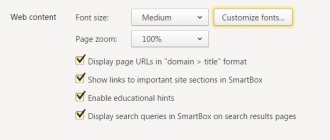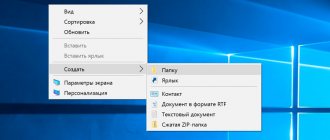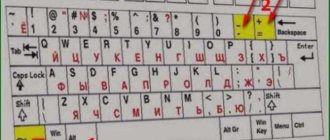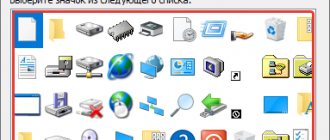By default, the desktop image fills the entire screen, is not distorted, is not cut off at the edges, and matches the display orientation. However, in some cases the picture may appear distorted or even upside down. The reasons for this screen behavior can be different, ranging from incorrectly set parameters to hardware problems. Let's see what can be done in such a situation, how to return the screen to its normal size and restore its original position.
Restore screen orientation
Changes in screen orientation are most often caused by incorrect actions by the user; less often, this occurs as a result of errors in third-party programs for managing display settings.
Using hot keys
If the screen is upside down, try using the following hotkeys first:
“ Ctrl + Alt + ↑ ” - restores the original screen position.
“ Ctrl + Alt + ↓ ” - flips the screen vertically.
“ Ctrl + Alt + → ” - rotates the image 90° to the right.
“ Ctrl + Alt + ← ” - rotates it 90° to the left.
Video card settings
If for some reason you cannot change the orientation using keyboard shortcuts, then you can use the control panel of the video card driver. It could be NVIDIA or Intel. Let's look at making changes to the settings on the Intel panel. Right-click on the desktop and select the “ Graphics characteristics ” option from the menu.
Click “ OK ” in the window that opens, and then on the panel itself, select Rotate → Rotate to normal view . Apply the settings. Graphics Options → Rotate → Rotate to normal view from the desktop context menu . The result will be similar.
Screen Resolution applet
You can also select the correct orientation of the picture in the “ Screen resolution ” settings, available from the same desktop context menu. Open them, select Landscape option Orientation and apply the settings. Screen resolution item in the Windows 10 desktop menu ; the required options in this version of the OS are located in the “ Display Settings application .
Changing the screen size of the output device in Word
- Open the document in Word.
Launching a new Word document
- Find the View tab in the toolbar.
Go to the “View” tab - Go to the “Scale” section, click on the button of the same name.
In the “Scale” section, click on the “Scale” icon
- In the dialog box that appears, select the best option.
Place a checkmark on the desired scale or enter an arbitrary value
- Confirm your actions by clicking on “OK”.
Click "OK"
What to do if the screen becomes narrow
Now let's look at the situation in which the monitor screen has narrowed. Let's see how to get it back. As a rule, narrowing of the screen and the appearance of black bars occurs when the resolution is incorrectly set. The problem can also be caused by the lack of a video card driver, connecting a second display or TV to the PC , or incorrect settings of the monitor itself.
Set the correct resolution
Open the “ Screen Resolution ” settings, as shown in the example with changing the screen orientation. To access them, you can also use the desk.cpl in the Run , which is called up with the Win + R . Set the recommended resolution using the slider or simply select the appropriate preset (in Windows 10). Save your settings. You can also set the appropriate resolution from the Intel Graphics Control Panel; by the way, in this way you can eliminate the image shift on the desktop to the right or left.
Update your video card driver
The problem in question often occurs due to a failure or incorrect installation (when reinstalling Windows) of the graphics card driver. In this case, you need to download the driver from the official resource of the manufacturer of your graphics card model and install it. If you find it difficult to choose a driver, use a special driver installation and update manager that can detect hardware, for example, DriverPack Solution.
Availability of an external monitor or TV
Restoring the screen when the second display is turned off will clearly point to it as the cause of the problem. To avoid this, the next time you connect a device, you will need to open the “ Screen resolution Multiple displays item and set the required resolution for each device manually.
Reset your monitor configuration
If none of the methods described above failed to restore normal orientation or resolution, reset the settings of the monitor itself. To do this, you need to press the “ AUTO ” hardware button located on the panel of your monitor.
Screen customization methods
Customization options may vary depending on the user's goal. For example, if the shortcuts on the desktop seem too large, but the text in applications and browsers does not stretch beyond the screen, you can do without changing the resolution: you just need to right-click on a free area of the desktop, select the “View” menu and check the box near the item “Small icons”.
In the same way, you can adjust icons for folders in Windows 7, 8 and 10, after first displaying the contents of any hard drive.
To change the scale in browsers, use the corresponding button, which is easy to find in the main menu. To make the text and image smaller, click on the minus button; to stretch them out, click on the plus button. In addition, in search engines, text documents and graphic editors, you can adjust the font sizes , panels and icons using special keyboard shortcuts:
- Hold down the Ctrl button and vary the scale of elements using the mouse wheel. When scrolling forward, the dimensions will increase, and when moving backward, they will decrease.
- While holding Ctrl, press the + and – buttons on the number pad on the right side of the keyboard.
To cancel changes and return the scale to its original state, you must press Ctrl+0.
If desktop elements, images and texts in applications increase disproportionately, making it difficult for the user to work, you should configure the correct screen extension. There are several options for performing this task.
System font settings
In addition to changing screen settings, Windows allows you to customize system fonts and some graphic elements. So, you can change the typeface and font size for individual Explorer elements, as well as change the scale of all interconnected elements. How to zoom in on your computer will be shown below. The most complete set of options for changing the graphical desktop environment is available in the now outdated Windows 7. In Windows 8.1 and 10, the ability to customize the environment is limited to developers, so to change parameters that are no longer accessible through the interface, you will have to use third-party utilities.
Through the settings of the OS itself
To open the corresponding settings in Windows 8.1 and 10, open the Win + R dpiscaling command in it . In Windows 8.1, this will open the interface of the classic “ Screen ” applet, in which you will be able to change the size of desktop elements and change only the font size for specific elements. Let's say you want to increase the text size of the Explorer icons. Select “ Icons ” from the drop-down list, and in the list next to it, specify the desired size and click “ Apply ”. Additionally, it supports changing user size parameters - scaling all desktop elements up to 500% by stretching the percentage scale.
Changing font settings in Windows 10
In Windows 10, the dpiscaling Display section , where only the scaling setting will be available to you. To be able to change the font size for specific elements, use the System Font Size Changer program. Having launched it, select the element you need by turning on the corresponding radio button, change its size using the slider and click “ Apply ”. You will need to sign out of your account to apply the changes.
How to Zoom Out Text on a Computer Screen
Often the problem of unsuccessful scale affects fonts. To avoid this, you must first understand where exactly the problematic font is located. Let's look at each problem and how to solve it.
If the text scale is bad on a particular site. In this case, you should use the tips from the section “How to make the screen smaller in the browser.” The fastest way is to use the combinations “Ctrl+/Ctrl-”, as well as “Ctrl” with the mouse wheel. It is not recommended to change global settings, since in this case you can solve one problem and create ten. These tips will not affect the entire system, but will help correct the font on a specific website or browser.
If it is difficult to read text in an office document, try the above combinations. Or open the file for editing (if possible), select the font and enlarge it. The scale slider at the bottom of the window will also help.
If the font is bad throughout the system. This problem is also easy to fix. Launch “Settings”, find the section “Special Features” - “Display”. At the top there is a slider that, by dragging it, adjusts the font size to suit you.
Why is the image upside down?
In most cases, the cause of screen flipping is the unintentional pressing of hot keys responsible for changing the screen orientation. Fixed by pressing a special keyboard shortcut, usually “ Ctrl + Alt + ↑ ”. After restoring the normal screen position, it is advisable to disable these shortcut keys from the desktop context menu.
Problems with drivers or other software. It occurs relatively rarely; to determine the exact cause of the failure, system components are diagnosed. Infecting the system with a virus can also lead to a similar problem. If an infection is suspected, a full scan is performed with an antivirus program and/or the system is rolled back to a previous restore point. If the measures taken are ineffective (many files are infected), a complete reinstallation of the system is performed.
Resizing while working in a text editor
Now it’s worth considering a way to change the screen size when you are working with documents or doing business on the Internet. The first case describes the procedure for Microsoft Word. To achieve your goal, follow these instructions:
- run the program;
- On the top panel of the window, find the tab called “View” and open it;
- Here you need to start the function of measuring the scale of screen elements; to do this, click on the button named “Scale”. It is an icon with a magnifying glass;
- After these steps, a special window will open in which you will be asked to adjust the image size.
Restoring the original screen scale
Additionally, it is recommended to pay attention to these settings. Use them when optimizing the system's operating environment parameters.
Changing the resolution
Screen resolution through the desktop context menu , set the recommended or most suitable resolution and save the settings. In Windows 10, go to the “ Display ” section and select the optimal resolution.
Hotkeys for scaling
To enlarge or reduce icons, the combination Ctrl + Plus and Ctrl + Minus . The method is simple, but not very convenient, since it is impossible to set your own step.
Here's a more subtle way of scaling. To change the size of elements, you need to scroll the manipulator wheel while holding Ctrl up or down. The drawback of this technique is the absence of a fixed step, which is why you can accidentally miss the desired scale.
You can also expand the screen on your computer using your keyboard by pressing Win + Plus . This action will call the standard “ Magnifier ” utility and zoom in on the screen.
How to make the browser screen smaller
Most often, you need to change the screen scale when using the Internet. The font on some websites may be too large or small, making it difficult to read. In such cases, it is not necessary to apply global settings for a short time. The hotkeys listed above for zooming out the screen can help. In addition, in each individual browser, developers build in the ability to change the scale. Their advantage is that the browser can remember the settings for each specific site. In this case, when you visit the resource again, the screen will not have to be “adjusted” again.
Google Chrome
In addition to standard hotkeys, you can use Chrome settings. To do this, click on the three dots in the upper right corner of the window. A context menu will open, one of the lines of which is called Zoom. By pressing “-/+” you can change the percentage value.
Opera
In Opera, everything works in a similar way. Click on the logo (upper left corner), and in the menu we find the line Scale. In it, the “+/-” buttons change the size of the information in the window.
Firefox
We don’t know who “ripped off” the location of the scale settings, but we have to admit that it turned out to be quite convenient. Click the three dots in the upper left corner of the window and change the value via “-/+” in the Scale line.
Yandex
To change the scale of the entire Yandex Browser, you need to open “Settings” - “Sites” - “Page Scale”. To change a specific resource, you need to click on the three dashes and change the scale. In addition, you can also use standard key combinations, as mentioned above.











